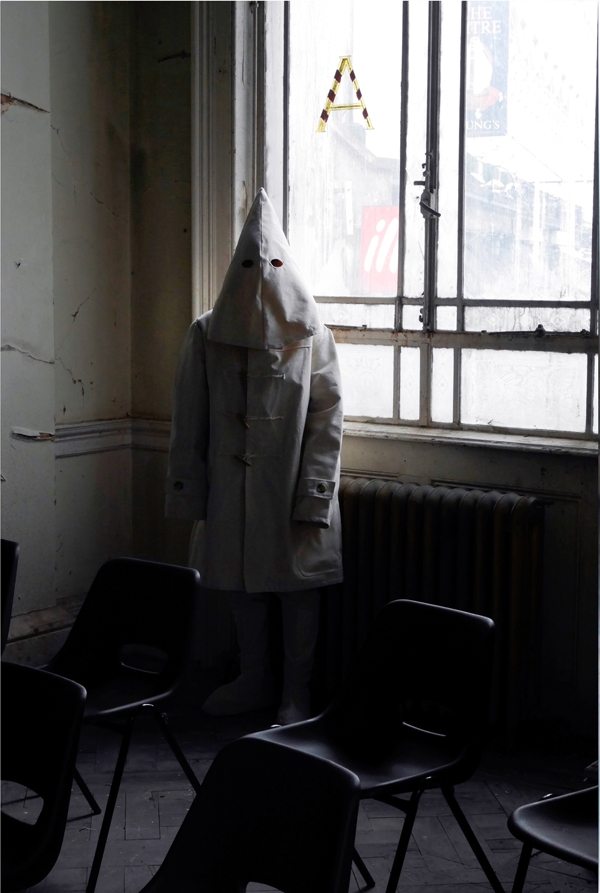16/04/17
Essay: Laura Moreton-Griffiths
Like the myth of Pandora, Laura
Moreton-Griffiths’ work might be seen as a kind of theodicy, addressing the
question of why there is evil in the world. Brought
up with a military background – her father was in
the Royal Navy and her mother briefly a Wren – discipline
and hierarchy were instilled in her from a young age, alongside a notion of patriarchy,
which might well have been defined as: ‘blind obedience […]; the repression of all emotions
except fear; the destruction of individual willpower; and the repression of
thinking whenever it departs from the authority figure’s way of thinking’.[1] A lot of her work is based on arguments she used to have with her
father, looking at human kindness and goodness and how ideologies get in the
way. A key photographic series, for example, is Portrait as my Father (2016), in which, in the tradition of many
female greats such as Claude Cahun, Cindy Sherman and Gillian Wearing, she
plays the role of the person she seeks to understand.

This
method seeps through her practice, be it photographic, drawn, installation-based,
or performative. Often objects created for one medium will resurface in
another. In Machine For Winning (2016),
inspired by the 1936 Olympics, Moreton-Griffiths takes on the roles, amongst
others, of dictator, spectator and mother. This series also sees her don what
she terms ‘a wearable painting’, in this instance an ironically lugubrious
smile, adopted from the 1930s’ Budapest Smile Club phenomenon, in which attendees
wore the smiles of such characters as the Mona Lisa and Loretta Young, fixed
Hannibal Lecter-like over their heads with medical tape, in an attempt to
counteract the city’s post-war suicide epidemic.
Moreton-Griffiths’
work reflects the things she is opposed to and thus necessarily deals with issues
of conflict, control and politics. She makes a piece with a specific
meaning, but then lets it go for her viewers to find a meaning of their own,
thus treading the line between personal and societal. Performance is key to her
practice and, for this, there must be costumes – and these costumes constitute
works in their own right. The Inglory
Suit, a Ku Klux Klan hood and
duffle coat, for example, or the less Machiavellian Gas Hood, become characters, whom Moreton-Griffiths takes on
outings, seeking out and ‘meeting’ other randomly related objects to be
photographed with.

The idea of
playing the role of evil, in particular with relation to the Klan, is one that
Philip Guston explored back in the 1960s: ‘The idea of
evil fascinated me […]. I almost tried to imagine that I was living with the
Klan. What would it be like to be evil? To plan, to plot.’[2] While
Guston grew up in Los Angeles,
the child of Ukrainian Jewish parents, only too aware of Klan persecution of
Jews, Blacks and others, Moreton-Griffiths has no such
personal history, simply a keen sense of what is right and wrong in this world
and a desire to unpick and understand the seemingly incomprehensible. Discovering
her work’s commonalities with Guston’s, however, she took some photographs of
herself in performance, wearingGas Hood and
the Klan hood, and turned them into Guston-like drawings. The characters in
these – with their echoes ofNosferatuand creeping 1930s’ monsters (read: right-wing ideologies) lurking in the
shadows – are now set to pop up elsewhere, so watch this space!

Moreton-Griffiths
also works with text – in particular, she redacts certain documents. From the
first page of the Human Rights Bill, for example, she has drawn out the words:
‘the incompatability of power to safeguard freedom’. From a page further in,
all that remains is: ‘terror terror terror terror terror’ – a very clear echo
of the patriarchal repression of all emotions
except fear.
Moreton-Griffiths’
work is not all doom and gloom, however, and it bears a strong comic
undercurrent. The plain white duffle coat, used as part of Inglory Suit, also appears elsewhere as her father’s arctic coat,
and this reappropriation, or alteration of identity, suggests that nothing and
no one is necessarily permanently fixed; redemption is always a possibility.
Although the opening of Pandora’s box
allowed evil into the world, hope remains inside.
[1] As defined by
the psychotherapist John Bradshaw in his book, Creating Love. Cited in bell hooks, The Will to Change. Men, Masculinity, and
Love, New York: Washington Square Press, 2004, p23.
[2] Guston quoted in Philip
Guston Paintings 1969-1980, exhibition catalogue,
Whitechapel Art Gallery, London, 1982, p54.
Images:
Sunk in the Arctic (2016)
From the series: Portrait as my Father
Collaborative digital photographic drawing on Arches Paper
112 cm x 140 cm
© Laura Moreton-Griffiths
A (2016)
Documentation of a performance.
Print on aluminium
30 x 20 cm
© Laura Moreton-Griffiths
The Group (2016)
Indian ink on Saunders Waterford paper
56 x 76 cm
© Laura Moreton-Griffiths
For more information on Laura Moreton-Griffiths, see her website